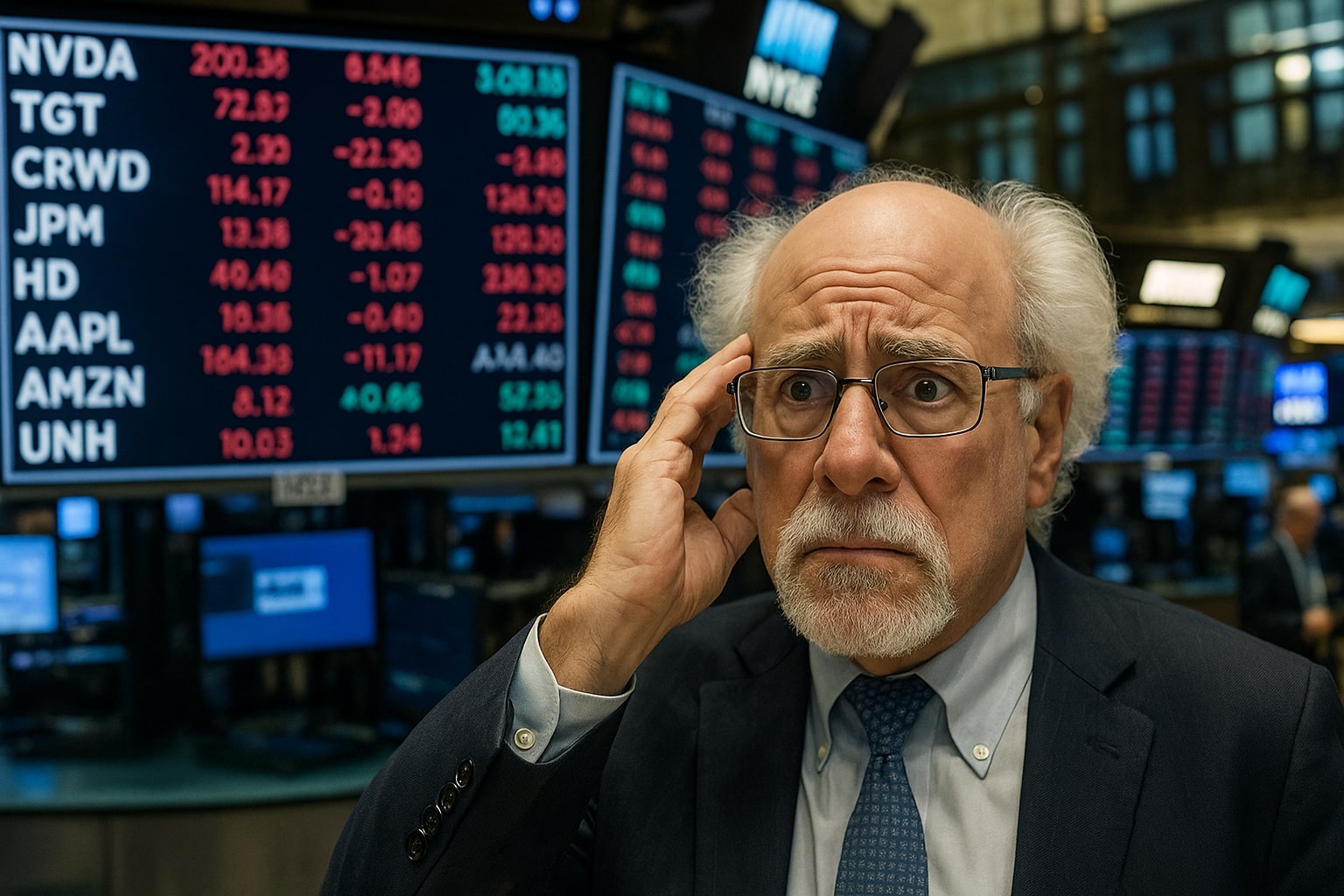U.S. Stock Market Faces Headwinds Amid Rising Treasury Yields
The stock market experienced significant volatility on Wednesday as investors reacted to the increase in Treasury yields and growing concerns about the U.S. fiscal situation. The Dow Jones Industrial Average dropped 330 points, or 0.8%, while the S&P 500 lost 0.5%, and the Nasdaq Composite slid by 0.3%. The primary catalyst for this downturn was the sharp rise in Treasury bond yields, with the 30-year Treasury yield surpassing 5% and the 10-year Treasury note yield trading above 4.53%. This surge in yields follows Moody's downgrade of U.S. credit last week, adding to the market’s unease.
Treasury Yields Surge, Adding Pressure to Stocks
Treasury yields have climbed notably in recent days, with the 30-year Treasury yield breaching the critical 5% mark, signaling increasing fiscal concerns. Analysts are worried that the government's fiscal space is shrinking due to rising debt levels, especially as the new tax bill currently under discussion could worsen the budget deficit. The Moody's downgrade and the recent increase in bond yields have added pressure to the stock market, with investors fearing that the government’s fiscal situation could become unsustainable. The broader market sentiment remains cautious, and this could weigh on the performance of equity markets in the short to medium term.
UnitedHealth (UNH) Faces Pressure After Downgrade
UnitedHealth (UNH) was among the worst performers in the Dow, falling more than 5% following a downgrade from HSBC. The downgrade came as a result of concerns about UnitedHealth’s leadership changes and the uncertainty surrounding the company’s future earnings potential. The healthcare giant has been facing numerous challenges, including a report alleging the company secretly paid nursing homes to reduce hospital transfers, a move that has sparked significant public backlash. These factors have contributed to the downward pressure on UnitedHealth’s stock, which has now become a drag on the broader market.
Tech Giants Like Apple (AAPL) and Amazon (AMZN) Struggle Amid Rising Rates
As Treasury yields continued to climb, major tech stocks, such as Apple (AAPL) and Amazon (AMZN), faced pressure. Both stocks dropped more than 1% as investors grew concerned about the impact of rising interest rates. Higher bond yields tend to affect tech stocks more significantly, as these companies rely on future growth prospects, which become less attractive as borrowing costs rise. The increase in Treasury yields coupled with a more cautious outlook for the broader economy has weighed on the performance of these high-growth stocks, although they remain key players in the long-term investment landscape.
Natural Gas (NG=F) Prices Surge Amid Geopolitical Tensions
Natural Gas (NG=F) futures saw a significant rise on Wednesday, reaching their highest level since May 14, hitting $3.513. This surge was driven by geopolitical factors, including the ongoing Russia-Ukraine conflict, which has had a persistent impact on energy markets. The increase in natural gas prices also comes as European natural gas prices reached their highest levels since April, highlighting the growing concerns over supply shortages. Despite this surge, the market remains volatile, and traders are carefully monitoring the evolving geopolitical situation, as it continues to have a profound impact on energy prices.
Retail Sector Struggles: Target (TGT) Cuts Outlook
Target (TGT) was another stock in focus on Wednesday as the retailer reported disappointing earnings results. The company missed revenue estimates for the first quarter and was forced to cut its full-year sales outlook. This move came in response to several headwinds, including weaker-than-expected consumer spending, the ongoing uncertainty surrounding tariffs, and the public backlash against the company’s rollback of diversity, equity, and inclusion (DEI) initiatives. These factors contributed to a 5% drop in Target’s stock, reflecting the growing concerns among investors about the challenges facing the retail sector. The company’s ability to navigate these issues remains a key factor for future stock performance.
Lowe’s (LOW) Beats Earnings Expectations Amid Housing Market Concerns
In contrast, Lowe’s (LOW) posted a strong earnings report on Wednesday, rising 2% following a better-than-expected first-quarter earnings performance. Despite housing market headwinds, Lowe’s managed to deliver earnings that exceeded expectations, with same-store sales showing some improvement, even in the face of unfavorable weather. Lowe’s has benefited from strategic investments in technology and its focus on the Pro customer segment, which has helped the company navigate the challenges in the retail space. This performance provides a brighter outlook for Lowe’s compared to some of its competitors, like Home Depot (HD), which has struggled with mixed earnings results.
Oil Prices Surge Amid Tensions in the Middle East
In the energy sector, Brent Crude (BZ=F) and West Texas Intermediate (CL=F) oil prices saw a surge following reports that Israel is preparing to strike Iran’s nuclear facilities. This geopolitical development has led to a rise in oil prices, with Brent Crude climbing above $66 per barrel, and WTI rising as much as 3.5%. The increase in prices reflects the growing uncertainty in the Middle East, particularly concerning Iran’s nuclear ambitions. If Israel moves forward with a strike, it could exacerbate tensions in the region, potentially disrupting global oil supplies and adding a risk premium to oil prices in the short term.
The Impact of Rising Treasury Yields on the Broader Market
The rise in Treasury yields continues to have a significant impact on the broader market. The increasing yields signal concerns about the U.S. fiscal situation, particularly with the ongoing discussions surrounding the new tax bill and the impact of the U.S. budget deficit. As yields rise, borrowing costs become more expensive, which can negatively affect corporate profits, especially for growth-focused companies in sectors like technology. While the stock market has seen strong gains recently, the bond market selloff and fiscal concerns are likely to continue influencing investor sentiment and market performance in the coming weeks.
Retail Investors Continue to Drive Market Momentum
Despite the concerns over rising yields and geopolitical risks, retail investors continue to play a significant role in the market. Data from JPMorgan shows that retail investors have been a driving force in the stock market rebound, contributing to a surge in buying activity. In fact, since April 8, retail investors have purchased $50 billion in stocks, accounting for roughly a third of daily trading volume. This buying activity has been crucial in maintaining momentum in the market, even as institutional investors have been more cautious.
CoreWeave (CRWV) Stock Surges After Earnings Report
On a more specific note, CoreWeave (CRWV) stock saw a substantial gain, rising over 10% on Wednesday following its first quarterly financial update as a public company. The company reported a revenue forecast that was far above Wall Street’s expectations, leading to an upgrade from Citi analysts, who raised their 12-month price target to $94 from $43. This surge reflects the positive momentum for CoreWeave, an Nvidia-backed AI company, which has become one of the more promising stocks in the AI space. However, despite this upward momentum, analysts have warned that the stock remains highly speculative and that profitability remains a key challenge.
The Broader Outlook: Risks and Opportunities Ahead
As we move further into the year, the stock market is facing a complex landscape. Rising Treasury yields, geopolitical uncertainties, and retail investor-driven market dynamics are all factors that traders must consider when making investment decisions. While some sectors, like energy and home improvement, are performing well, concerns about the U.S. budget deficit, tariffs, and inflation remain significant headwinds. The continued volatility in oil prices and natural gas prices will also likely shape the market in the coming weeks. Investors should carefully monitor these developments and adjust their portfolios accordingly to navigate the risks and opportunities that lie ahead.



















